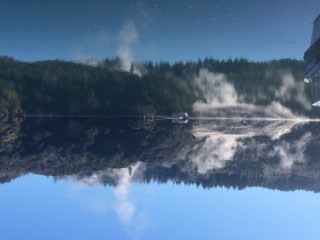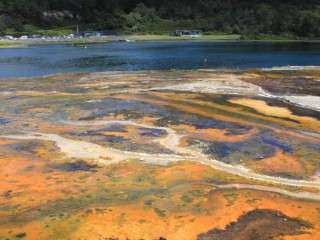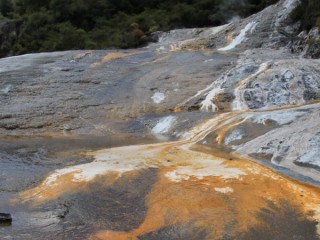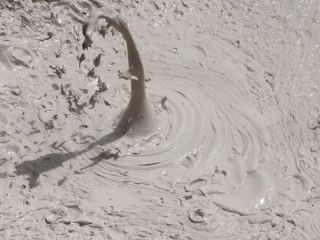The Chemistry and Microbiology at Geothermal Sites
The page provides information on the chemical processes and the various microbiological organisms that occur and live at the geothermal site that is Orakei Korako.
Overview
 The hot springs, geysers and clear blue pools at Orakei Korako discharge alkali chloride water. This water ascends quickly to the surface from deep reservoirs where the temperature is hotter than 175°C.
The hot springs, geysers and clear blue pools at Orakei Korako discharge alkali chloride water. This water ascends quickly to the surface from deep reservoirs where the temperature is hotter than 175°C.
Upon discharge at the surface these waters cool. As they cool below 100°C, the silica that is carried in the water is deposited at the surface, forming the white silica sinter terraces. Sinter is rock that is formed over time by the deposition of silica from thermal water.
Faulting controls where the thermal water discharges by opening cracks in the rocks. Faulting not only provides open paths for the waters to flow through, but the fault movements have also produced the stepped terraces, which are covered in silica sinter.
On the western side (lake side) of the fault lines, the sinter sheets have been downthrown to create the stepped sinter terraces.
Silica has been depositing, forming sinter from the cooling alkali chloride waters at the surface, well before the 186 AD Taupo volcanic eruption which formed Lake Taupo. Follow the boardwalk to experience one of New Zealand's most impressive geothermal fields.
Microbial Mats
 Different types of microbial mats cover the sinter terraces, the colour indicating the type of microbe. The water level and flow rate are continually changing. The colourful terraces in turn respond with colour changes as the living mats shift with their environment.
Different types of microbial mats cover the sinter terraces, the colour indicating the type of microbe. The water level and flow rate are continually changing. The colourful terraces in turn respond with colour changes as the living mats shift with their environment.
Black/brown microbial mats - microbes comfortable at temperatures lower than 35°C live here.
Orange mats house the more heat loving microbes at temperatures between 35-59°C in shallow waters. The orange colour is carotenoid pigment - or sunscreen. These mats live very close to the surface and need this protection against the ultra-violet light.
Green mats - accommodate microbes that also like warmer temperatures of 35-59°C. These microbes live in deeper water which gives them protection from the ultra-violet light.
Not all microbes form bubbles. Microbes that form bubble mats can form different shaped and sized bubbles depending on their environment. Elongated bubble mats form in the fast flowing channels where they become stretched by the rapid flow of water.
When the terraces are dry, there are no microbial mats at all.
Silica is depositing on these living microbes and they are constantly racing against time for their survival. When silica deposits faster than the rate of microbial growth, the little microbes become entombed, silicified and fossilised into the sinter.
 Streamer Microbial Mats
Streamer Microbial Mats
While the colours of the microbial mats indicate water temperature, the textures of the mats indicate fluid flow rate and water depth.
Elongated mats form in the fast flowing channels. These microbes grow in long strands, shaped in response to the rapidly flowing water.
Bubble Mats
Between the Emerald and Rainbow Terraces, to the left of the boardwalk on the Emerald Terrace, living orange and green microbial bubble mats and partially silicified bubble mats occur side by side.
The white periphery around the bubble mats is silica sinter. here the rate of silica deposition is greater than the rate of microbial growth.
Eventually so much silica will deposit that the microbes will die and become totally silicified, leaving their fossilised signature in the sinter. Then the sinter becomes a source of information about the environment at the time of silicification, indicating conditions such as water temperature and flow rate.
Hydrothermal Eruptions
Hydrothermal eruption craters are distinctly different from volcanic eruption craters.
Hydrothermal eruptions are common in active geothermal systems. They occur because the pressure of the gases and/or water builds up below the ground level until eventually it reaches the point where the pressure is so great, an eruption occurs. The eruption releases the pressure and generates steam, lifting the rocks and mud in an explosive burst.
They can happen quickly and last for a few hours or several days. Water near boiling temperature suddenly flashes to steam if the water temperature increases or the pressure is lowered. The expansion of the steam provides the lift that ejects rocks and mud and creates the eruption.
Some eruptions are caused by pressure changes when the water table is lowered while others are triggered by earthquakes. When the ground is stable again, water may fill the crater forming a crater lake or pool Magma is not needed for these eruptions.
The Ageing Miracle of Silica Sinter
Silica sinter is unique in the way it is not buried, yet it still transforms into rock. This happens as the properties of the silica change form one form to another form. Silica is initially deposited as opal-A which with time turns into opal-CT+ / -opal-A and eventually forms quartz. This change occurs as water is lost from the silica structure and the silica particles reorganise themselves into a more tightly packed form.
The reorganisation of the silica particles causes distinct mineralogical and textural changes to take place within the silica sinter. A series of microscope images that show the sequence (as well as much more) is available in the book and is an invaluable guide to your tour of Orakei Korako.
Fossilised Microbial Mats
By studying the fossilised microbes we can learn about the past climates and environments that existed at the time the silica was deposited upon the microbes. For example, we know that low-temperature microbes look different from mid- or high-temperature microbes, both while they are alive and when they become fossilised in silica sinter. Hot spring environments may have been the site for life's origins on Earth and possibly Mars. By studying the fossilised microbes found in hot spring environments on Earth we can learn how to recognise them in other thermal settings, such as Mars.
Fossilised microbes are seen in the cliff face. These outcrops of silica sinter are located above the Golden Fleece Terrace, and higher than the current discharging water level. They represent earlier discharges of alkali chloride water at a higher level than today.14C or carbon dating of pollen grains revealed this older sinter outcrop to be approximately 1800 years old.
Fumaroles
Fumaroles are vents that discharge steam and gas. Steam from a fumarole destroys the vegetation surrounding it. Dead, brown or burnt vegetation indicate that a fumarole has been or is currently active in the area. The ground surrounding fumaroles is very dangerous because the steam and acidic gases eat into all the rocks and soil they come in contact with. The hold visible at the surface is often considerably smaller than the cavity beneath the ground. Steaming ground and fumaroles are considered to be amongst the most dangerous areas to work in a geothermal field.
Some fumaroles discharge constantly while others discharge intermittently. The amount of steam and gas released also varies from fumarole to fumarole and day to day. Vent sizes range from millimetres to metres in diameter.
- Carbon dioxide (CO2) is the main gas vented
- Steam contains hydrogen sulphide (H2S) which can cause yellow sulphur to deposit around the vent
- The steam temperature of fumaroles at Orakei Korako varies from 30 - 98°C
 Mud Pools
Mud Pools
At Orakei Korako the local rocks, including the 186 AD Taupo Ignimbrite, get altered by acid over time to clay. It is this liquid clay that forms the thick, muddy pools.
Steam and carbon dioxide (CO2) are discharged by numerous small vents in the pool floor. The bubbling in the pools is caused by carbon dioxide gas being released with the ascending steam.
- The temperature in mud pools is usually less than 100°C
- Mud pools are always acidic and occur above the water table
- No silica sinter forms here because silica cannot be carried in the steam phase
Taupo Ignimbrite
Ignimbrite from the 186 AD Taupo eruption is preserved in several cliff faces at Orakei Korako.
- Ignimbrites are formed as the result of hot, violently erupted clouds of gas, ash and pumice from a volcanic eruption, depositing back on the Earth
- The temperature of the material erupted is so high that when it is deposited, the edges of some fragments melt then weld together. The welded sheet of ash and pumice is called ignimbrite
- Ash is the unconsolidated fine-grained material formed as a result of a volcanic eruption
- Pumice is an extremely light weight, porous rock, usually white, derived from silica-rich lava
Geochemistry of the Water
- Most waters at Orakei Korako are alkali chloride with a near-neutral pH
- Chloride (Cl-) is the main constituent in these waters, along with lesser quantities of sodium (Na+), potassium (K+) and calcium (Ca2+)
- They also contain variable but significant amounts of sulphate (SO42-) and bicarbonate (HCO3-)
- Carbon dioxide and hydrogen sulphide (H2S) are the two most common gases associated with chloride waters
- When silica sinter is deposited at the surface, the deep reservoir temperature exceed 175°C
- These waters contain variable concentrations of silica. Silica concentrations indicate proximity to the heat source.
- High concentrations of silica (SiO2) in the alkali chloride water indicate that the water discharging at the surface is close to the heat source. A low concentration of silica means the heat source is a long way from the surface discharge point.
- As alkali chloride water cools, silica is deposited from the water forming silica sinter deposits. Only alkali chlorde waters deposit silica sinter.
- Alkali chloride springs form clear, blue pools
- Acidic waters occur where gases rise above the water table and discharge in the form of mud pools and steaming ground. Silica can not be carried to the surface by the gases that create the acidic conditions. Silica around acid pools occurs after the local rock has been partly dissolved and is called silica residue
- Steam used for power production generation comes only from alkali chloride waters and not from acidic waters as the acids eat into and corrode machinery





